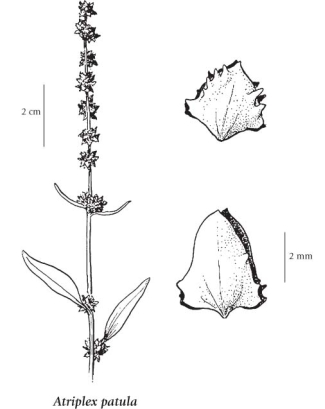Atriplex patula L.
common orache (spear saltbush)
Amaranthaceae (Amaranth family)
(Previously in Chenopodiaceae)
Introduction to Vascular Plants
common orache (spear saltbush)
Amaranthaceae (Amaranth family)
(Previously in Chenopodiaceae)
Introduction to Vascular Plants
Species Information
General:
Annual herb from a taproot; stems erect or ascending, simple or branched, 5-80 cm tall.
Leaves:
Lower leaves opposite, upper leaves alternate, stalked or stalkless, 1-10 cm long, lanceolate to broadly lanceolate, 2-4 cm wide, rounded at the base, smooth or toothed, upper leaves green below, others covered with a whitish mealy substance above and below when young, but becoming glabrous and greenish with maturity.
Flowers:
Inflorescence of terminal or axillary spikes or panicles; pistillate bracteoles somewhat basally thickened at maturity, the largest bracteoles somewhat diamond-shaped, margins united almost to the middle, lateral teeth present, densely compressed in the inflorescence, more or less uniform in size, 3-6 mm long.
Fruits:
Membranous pericarps; seeds erect, 1.5-2.5 mm long.
Illustration

If more than one illustration is available for a species (e.g., separate illustrations were provided for two subspecies) then links to the separate images will be provided below. Note that individual subspecies or varietal illustrations are not always available.
Illustration Source: The Illustrated Flora of British Columbia
Ecology
Ecological Framework for Atriplex patula
The table below shows the species-specific information calculated from
original data (BEC database) provided by the BC Ministry of Forests and Range.
(Updated August, 2013)
The table below shows the species-specific information calculated from
original data (BEC database) provided by the BC Ministry of Forests and Range.
(Updated August, 2013)
| Site Information |
Value / Class |
||
|
Avg |
Min |
Max |
|
| Elevation
(metres) |
1 | 0 | 5 |
| Slope
Gradient (%) |
0 | 0 | 2 |
|
Aspect (degrees) |
54 | 54 | 54 |
| Soil
Moisture Regime (SMR) [0 - very xeric; 4 - mesic; 8 - hydric] |
6 | 5 | 7 |
| Modal
Nutrient Regime
Class |
D | ||
| #
of field plots species was recorded in: |
7 | ||
| Modal
BEC Zone Class |
CWH | ||
|
All BEC Zones (# of stations/zone) species was recorded in |
CDF(2), CWH(5) | ||
|
Source:
Klinkenberg 2013
|
|||
Habitat and Range
Mesic roadsides, waste places and gardens in the lowland, steppe and montane zones; frequent in S BC; probably introduced from Eurasia.Status Information
| Origin Status | Provincial Status | BC List (Red Blue List) | COSEWIC |
|---|---|---|---|
| Exotic | SNA (2019) | Exotic | Not Listed |
BC Ministry of Environment: BC Species and Ecosystems Explorer.
Synonyms
Synonyms and Alternate Names:
Atriplex hastata sensu Aellen, non L.
Atriplex latifolia Wahlenb.
Atriplex patula subsp. hastata sensu H.M. Hall & Clem. 1923, non (L.) H.M. Hall
Atriplex patula var. bracteata auct. non Westerlund
Atriplex patula var. erecta (Huds.) Lange
Atriplex patula var. hastata auct. non (L.) A. Gray
Atriplex patula var. japonica Level.
Atriplex patula var. patula
Atriplex patula var. triangularis (Willd.) Thorne & S.L. Welsh
Atriplex prostrata var. triangularis (Willd.) Rauschert
Atriplex triangularis Willd.
Taxonomic Notes
"The genus Atriplex, commonly called orache, atriplex or saltbush, of the family Chenopodiaceae (the goosefoot family), comprises nearly 200 species. The genus has a worldwide distribution, occurring on all continents except Antarctica. Most of the species are halophytes of coastal or inland saline habitats; a few are widespread ruderals of disturbed ground." (Bassett et al. 1983).
References Bassett, I. J., C. W. Crompton, J. McNeill and P. M. Taschereau. 1983. The genus Atriplex (Chenopodiaceae) in Canada. Monograph #31, Agriculture Canada, Ottawa. |